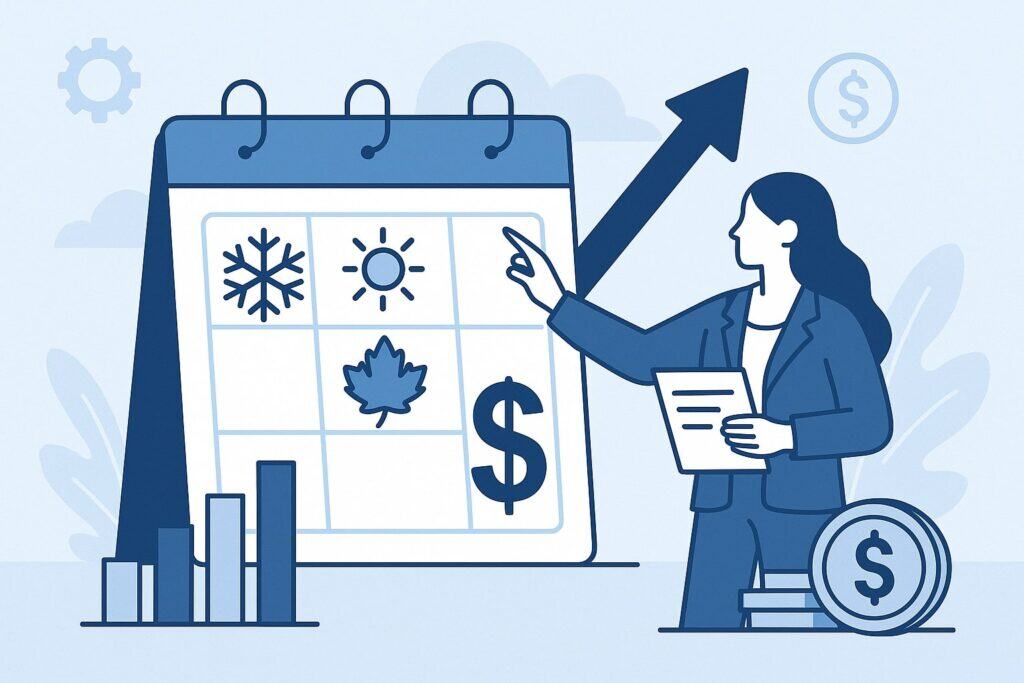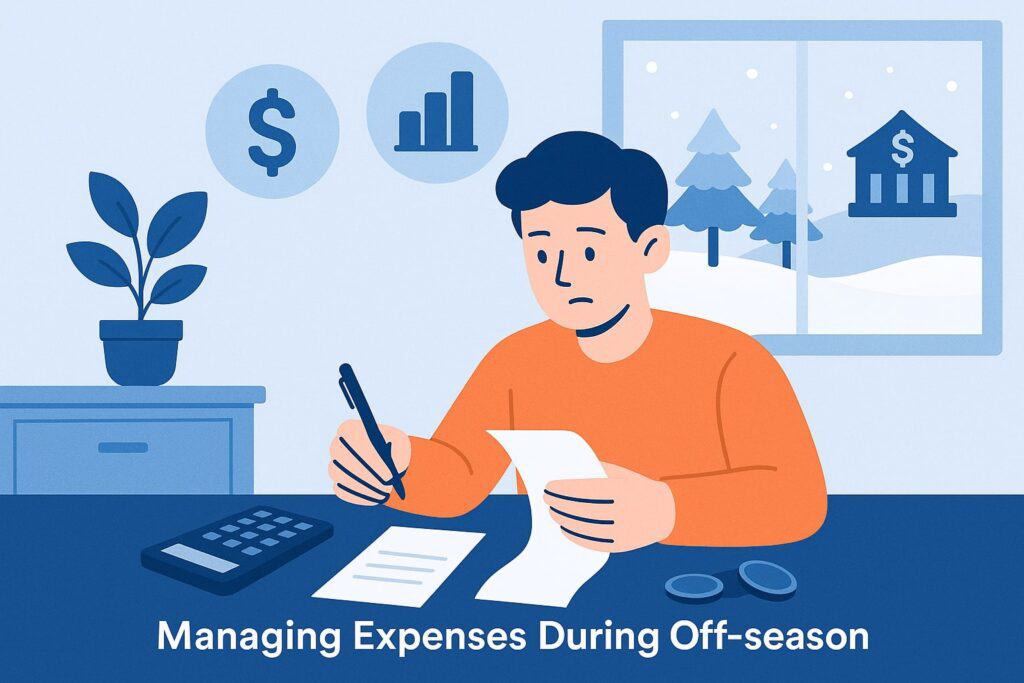
How to Plan for Seasonal Business Cash Flow Needs
Seasonal businesses face unique financial challenges because demand rises and falls based on specific times of the year. Retailers rely on holiday shopping spikes, landscapers thrive in warmer months, and ski resorts earn most of their revenue in winter.
While these cycles can be highly profitable, they also create extended off-seasons where revenue is lower. This uneven income pattern often leads to cash flow gaps, making it difficult to cover fixed expenses like rent, payroll, inventory restocking, and utilities.
Planning for seasonal business cash flow needs is not simply about surviving the lean months—it’s about ensuring long-term stability and growth. A well-prepared business can avoid the stress of last-minute borrowing, take advantage of supplier discounts, and even invest in marketing during slow periods to secure future sales.
Without proper planning, businesses risk missed opportunities, increased debt, and in worst cases, insolvency.
This guide provides an in-depth roadmap on how to anticipate, plan, and manage cash flow for seasonal businesses. It covers forecasting techniques, financing strategies, expense management, and real-world applications to help owners stay financially resilient year-round.
Understanding Seasonal Business Cash Flow

Cash flow refers to the movement of money in and out of your business. For seasonal businesses, the challenge is that inflows (sales revenue) do not arrive consistently every month, but outflows (operational costs) remain steady. This creates pressure during off-seasons, where expenses outweigh income.
For example, a toy retailer may make 60% of annual sales during November and December. However, rent, staff salaries, and supplier payments are due all year. Without planning, January and February can become cash-strapped months, even after a highly successful holiday season.
Similarly, a summer-based tourism business may face nine months of low activity but still need funds to maintain properties, pay licensing fees, and prepare for peak season.
Understanding this cycle begins with identifying your business’s revenue peaks and troughs. A three-to-five-year financial history provides valuable insights into sales fluctuations, customer demand, and expense patterns.
Even new businesses can use industry benchmarks and competitor insights to anticipate their seasonal curves. By visualizing cash inflows and outflows month-by-month, you’ll see when surpluses and shortfalls occur, which forms the foundation for planning.
It’s also important to recognize that not all seasonality is predictable. Weather disruptions, economic downturns, or shifting consumer preferences can affect seasonal revenue.
For instance, a mild winter can reduce ski resort bookings, while inflation can reduce discretionary holiday spending. Businesses that understand these external influences can create contingency strategies like diversifying product lines or building emergency reserves.
Ultimately, managing seasonal cash flow is about balancing predictability with flexibility. You know when your busy and slow months occur, but you must also prepare for unexpected events. A strong understanding of your financial patterns gives you the power to plan proactively instead of reacting under stress.
Building an Effective Cash Flow Forecast

Cash flow forecasting is the backbone of seasonal financial planning. A forecast projects your business’s expected inflows (sales, loans, customer payments) and outflows (rent, wages, inventory, utilities) over a given period—typically 12 months.
For seasonal businesses, this forecast should extend across at least one full year, if not multiple, to account for recurring patterns.
Steps to Build a Forecast:
- Gather Historical Data – Review at least three years of financial statements, noting monthly revenue and expense trends. Look for recurring high and low sales periods.
- Identify Seasonality Patterns – Highlight which months generate peak revenue and which months historically underperform. Overlay external factors like holidays, weather, and school schedules that influence sales.
- Estimate Fixed vs. Variable Costs – Fixed costs (rent, salaries) remain constant, while variable costs (inventory, shipping, seasonal staff) fluctuate with sales. Mapping both ensures accuracy.
- Incorporate Growth Projections – If you expect a 10% increase in sales this year, reflect that in your forecast, but remain conservative to avoid overestimating.
- Prepare for Delays – Customers may delay payments, suppliers may demand upfront deposits, and unexpected costs can arise. Build in buffers for such scenarios.
Why Forecasting Matters:
- It reveals when cash shortages are most likely to occur.
- It allows you to secure financing in advance rather than in a crisis.
- It helps you prioritize expenses during lean months.
- It enables smarter investment decisions during surplus periods.
One practical method is using rolling forecasts—updating projections monthly with real sales and expense data. This keeps the forecast dynamic and aligned with current realities. Technology also plays a role: cloud-based accounting software and business intelligence tools make it easier to track, update, and analyze forecasts in real time.
The accuracy of your forecast directly impacts your financial stability. An overestimated forecast can lead to overspending and debt accumulation, while an underestimated forecast may cause missed opportunities.
Therefore, businesses should regularly compare forecasted numbers with actuals, adjusting strategies to close gaps.
With a solid forecast, businesses can see several months ahead, enabling them to take corrective action before cash shortages occur. Instead of being reactive, owners become proactive financial managers.
Managing Expenses During Off-Season

The off-season is where seasonal businesses face the greatest risk. Even without sales, expenses continue to pile up. Rent, insurance, utilities, and payroll obligations don’t pause just because customers aren’t buying. Strategic expense management during these periods ensures survival until peak season returns.
Key Strategies:
- Reduce Variable Costs – Scale down non-essential services, marketing, or labor costs when revenue dips. For example, reduce operating hours, renegotiate supplier contracts, or temporarily lay off seasonal workers.
- Negotiate with Vendors – Many suppliers are open to flexible payment schedules for seasonal businesses. Establish agreements that align with your cash flow cycle—paying more during peak months and less during slow ones.
- Adopt Lean Operations – Eliminate unnecessary subscriptions, delay non-urgent equipment purchases, and reduce inventory to avoid tying up cash in unsold stock.
- Cross-Utilize Staff – Instead of layoffs, train employees to handle multiple roles, ensuring efficiency with fewer people on payroll.
- Maintain Essential Investments – While cutting costs is crucial, avoid cutting back on activities that secure future revenue, like customer engagement, brand visibility, and necessary maintenance.
Expense management also requires balancing short-term survival with long-term sustainability. Cutting too deeply into areas like marketing or equipment upkeep may harm future sales.
For instance, if a landscaper reduces marketing in winter, they may struggle to acquire new clients in spring. Therefore, the key is prioritizing expenses that directly support customer retention and revenue growth.
A practical tool here is the zero-based budgeting approach—where every expense must be justified for each new period, rather than rolling over past budgets. This method ensures that only necessary and high-value costs remain, preventing unnecessary spending during slow seasons.
Smart expense management doesn’t just save money; it strengthens resilience. By controlling outflows during off-seasons, businesses reduce the strain on savings or financing, allowing them to allocate resources more effectively when peak demand returns.
Financing Options for Seasonal Businesses
Even the best-managed seasonal businesses may need extra financial support during off-seasons or to prepare for peak seasons. Financing provides the liquidity to bridge cash flow gaps, purchase inventory, or fund marketing campaigns. The key is choosing the right type of financing and securing it before the need becomes urgent.
Common Financing Solutions:
- Business Lines of Credit – Provides flexible borrowing up to a set limit, only paying interest on the amount used. Perfect for covering short-term gaps.
- Short-Term Loans – Fixed lump sum repaid over months. Useful for preparing for peak season with upfront inventory purchases.
- Invoice Financing – Advances cash against unpaid invoices, ensuring smoother cash flow when customers delay payments.
- Merchant Cash Advances – Provides funds based on projected credit card sales. Though convenient, these often carry high fees.
- SBA Loans – Government-backed loans with favorable terms, though they require detailed paperwork and approval processes.
- Trade Credit – Agreements with suppliers that allow delayed payments, aligning expenses with revenue cycles.
Choosing the Right Option:
The ideal financing solution depends on your cash flow cycle, credit history, and repayment ability. For example, businesses with predictable peak-season income may find short-term loans practical, while those with fluctuating demand may prefer flexible lines of credit.
The timing of securing financing is equally important. Lenders are more willing to extend credit when your finances look healthy, not when you’re in a crisis. Planning ahead allows you to negotiate better rates and terms.
Additionally, businesses should evaluate the true cost of borrowing, including interest rates, fees, and repayment structures. While financing provides relief, poor management can lead to debt traps. The goal is to use financing strategically—as a bridge between seasons, not as a permanent crutch.
Building and Maintaining a Cash Reserve
A cash reserve, often called a “rainy day fund,” is one of the most effective defenses against seasonal cash flow challenges. It provides a financial cushion during lean months, reducing reliance on borrowing and ensuring stability when unexpected expenses arise.
Benefits of a Cash Reserve:
- Peace of Mind – Owners can focus on strategy instead of worrying about paying bills.
- Flexibility – Businesses can take advantage of bulk purchasing discounts or last-minute opportunities.
- Reduced Debt Dependence – Less need for high-interest loans during off-season.
- Emergency Coverage – Acts as a buffer against unforeseen disruptions like weather events or supply chain issues.
Building a reserve takes discipline. A general rule is to set aside at least 10–20% of peak season profits into a dedicated savings account. Over time, this can accumulate into several months’ worth of operating expenses.
To strengthen reserves, businesses can also funnel unexpected windfalls—such as tax refunds, bonuses, or surplus profits—into savings instead of reinvesting immediately.
Maintaining a reserve requires consistent review. As business expenses grow, the reserve target should increase accordingly. Automating transfers into a reserve account ensures consistency without relying on manual discipline.
Ultimately, a strong reserve transforms seasonal unpredictability into manageable cycles. Instead of panicking during slow months, businesses can strategically use their savings to cover costs while planning for the next surge in demand.
Leveraging Technology for Cash Flow Management
Technology has revolutionized how businesses track, forecast, and manage cash flow. Seasonal businesses, in particular, benefit from real-time insights and automation that reduce errors and improve financial decision-making.
Useful Tools:
- Accounting Software – Platforms like QuickBooks, Xero, and FreshBooks help track income and expenses, generate forecasts, and monitor profitability.
- Cash Flow Apps – Tools like Float or Pulse integrate with accounting software to provide visual forecasts and scenario planning.
- Inventory Management Systems – Software that aligns stock levels with seasonal demand, preventing over-purchasing or stockouts.
- Payment Processing Solutions – Offering multiple payment methods and faster settlement options ensures quicker access to cash.
Beyond tracking, technology allows businesses to run “what-if” scenarios. For example, if revenue drops 15% during peak season, how long can reserves last?
Or if expenses increase unexpectedly, how much financing would be needed? These simulations help owners make informed, proactive decisions.
Digital tools also improve transparency. With mobile apps and dashboards, business owners can monitor finances on the go, ensuring they’re never blindsided by cash shortages. Furthermore, automation reduces manual work, minimizes errors, and ensures timely invoicing and payments.
Marketing and Sales Strategies to Balance Seasonality
Cash flow challenges don’t always have to be managed with cost-cutting alone. Strategic marketing and sales efforts can generate off-season revenue streams, reducing financial pressure.
Approaches:
- Diversify Product/Service Offerings – For example, a summer surf shop could sell fitness gear year-round. A winter ski resort could host summer hiking tours.
- Gift Cards and Pre-Sales – Offering discounts for advance bookings or prepaid packages secures cash upfront.
- Loyalty Programs – Encourage repeat purchases during off-season through exclusive discounts or membership perks.
- E-Commerce Expansion – Seasonal businesses can sell online to expand beyond local and seasonal demand.
- Partnerships and Collaborations – Cross-promote with complementary businesses to reach wider audiences.
The key is identifying ways to extend customer engagement beyond peak seasons. Businesses that maintain brand visibility year-round secure stronger demand once the busy months return. Proactive marketing during slow periods also prevents competitors from capturing customer attention.
FAQs
Q1. How far in advance should I plan for seasonal cash flow needs?
Answer: Planning should ideally begin at least 12 months in advance, covering a full business cycle. This ensures you can forecast accurately, secure financing early, and build reserves before they’re needed. Businesses that delay planning until the off-season often face limited financing options and higher borrowing costs.
Long-term planning also allows businesses to take advantage of early supplier discounts, negotiate favorable terms, and strategically invest in marketing to maximize peak season profits. The more proactive you are, the more financial stability you’ll enjoy year-round.
Q2. What’s the biggest mistake seasonal businesses make with cash flow?
Answer: One of the most common mistakes is overestimating peak season revenue and underestimating expenses. Many businesses assume that one strong season will carry them through the year, only to realize expenses outpace income during slower months.
Another mistake is failing to separate profits from reserves—owners reinvest everything immediately, leaving little cushion for the off-season.
To avoid these pitfalls, businesses must adopt conservative forecasts, maintain reserves, and regularly compare actual results with projections. Adjusting strategies in real time ensures you stay on track instead of waiting for problems to snowball.
Q3. Should I always rely on financing for off-season needs?
Answer: Not necessarily. Financing is a valuable tool but should be used strategically, not habitually. Relying solely on debt to cover seasonal gaps can lead to mounting interest expenses and long-term dependency.
Ideally, financing should supplement other strategies, such as maintaining reserves, managing expenses, and generating off-season revenue.
If financing is necessary, secure it during peak months when your financials look strongest. Lenders are more likely to offer favorable terms when they see healthy sales, not when you’re already struggling with cash shortages.
Q4. How do I handle unexpected disruptions, like bad weather or economic downturns?
Answer: Unexpected disruptions can devastate seasonal businesses that rely on predictable peaks. The best defense is diversification and preparation. Diversify your offerings so you’re not entirely dependent on one season. For example, a ski lodge might offer summer hiking packages to offset mild winter losses.
Additionally, maintaining an emergency fund and flexible financing options ensures you can survive disruptions. While no plan can prevent unpredictable challenges, proactive risk management reduces the likelihood of catastrophic financial consequences.
Q5. Can technology really make a difference in seasonal cash flow management?
Answer: Yes, technology plays a significant role. Real-time financial tracking, automated invoicing, and digital forecasting tools provide immediate insights that were once difficult to obtain. This allows businesses to anticipate shortages earlier and adjust strategies accordingly.
Beyond cash flow management, technology also opens new revenue channels through e-commerce, online booking systems, and digital marketing. By leveraging tech, seasonal businesses can extend reach, improve efficiency, and build resilience against financial fluctuations.
Conclusion
Seasonal business cash flow management is a balancing act between preparing for the predictable and protecting against the unpredictable. Success comes from proactive planning, disciplined financial management, and the ability to adapt.
By forecasting accurately, managing expenses, securing strategic financing, building reserves, and leveraging technology, seasonal businesses can transform volatile income cycles into sustainable growth.
Instead of dreading off-seasons, well-prepared businesses use them to regroup, innovate, and position themselves for stronger peak performance. With the right strategies, seasonality doesn’t have to be a financial weakness—it can become a competitive advantage.